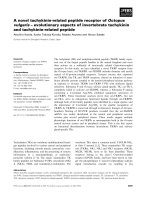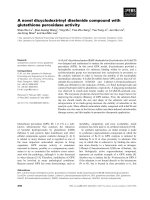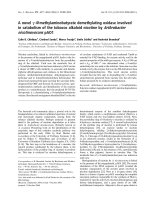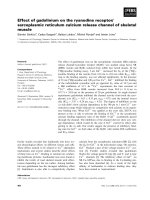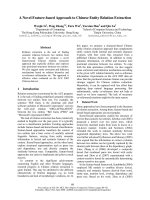báo cáo khoa học: " A novel mutation in the calcium-sensing receptor gene in an Irish pedigree showing familial hypocalciuric " doc
Bạn đang xem bản rút gọn của tài liệu. Xem và tải ngay bản đầy đủ của tài liệu tại đây (520.48 KB, 5 trang )
CAS E REP O R T Open Access
A novel mutation in the calcium-sensing receptor
gene in an Irish pedigree showing familial
hypocalciuric hypercalcemia: a case report
Wael F Elamin
1,2*
, Olivier de Buyl
1
Abstract
Introduction: Familial hypocalciuric hypercalcemia is a rare autosomal dominant disorder characterized by
asymptomatic and non-progressive hypercalcemia due to mutations of the calcium-sensing receptor gene.
Disorders of calcium metabolism are very common in the elderly, and they can coexist with familial hypocalciuric
hypercalcemia in affected families.
Case presentation: We describe an Irish family with hypercalcemia and hypocalciuria. The proband, an 80-year-old
Irish woman, presented with hypercalcemia, relative hypocalciuria, and an elevated parathormone level. She also
had chronic kidney disease stage 3 and vitamin D deficiency. Two of her sons were also found to be
hypercalcemic and hypocalciuric. DNA sequencing identified a novel missense inactivating mutation in the calcium
sensing-receptor gene of the proband and her two hypercalcemic sons.
Conclusion: Familial hypocalciuric hypercalcemia due to a novel mutation in the calcium-sensing receptor gene
was diagnosed in the proband and her two sons. Disorders of calcium metabolism can be multifarious in the
elderly. We suggest that testing first degree relatives for calcium levels and DNA sequencing may have a role in
the assessment of elderly patients with parathormone-related hypercalcemia.
Introduction
Familial hypocalciuric hypercalcemia (FHH) is a rare
autosomal dominant disease that runs a benign course.
Its prevalence is not clearly established [1]. It is impor-
tant to differentiate it from the much more common pri-
mary hyperparathyroidism (PHPT) to avoid unnecessary
and potentially ha rmful parat hyroidectomy [2]. It has
been shown to result from heterozygous inactivating
mutations in the calcium-sensing receptor (CaSR)gene
in the majority of cases [3]. The calcium sensing re ceptor
(CaSR) is a G-protein-coupled receptor of 1078 amino
acids (AAs) with a large extracellular domain and the
characteristic seven-transmembrane domains [4]. It is
expressed in the parathyroid gland, kidneys, bones, and
other tissues [5] and plays a key role in the maintenance
of constant levels of extracellular ionized calcium. It
modulates the function of chief cells of the parathyroid
gland, stimulating the synthesis and secretion of PTH as
well as the proliferation of parathyroid cells when the cal-
cium level is low, and inhibiting these functions when the
calcium level is high. In the kidneys, the CaSR decreases
calcium reabsorption, increases calciuresis, and decreases
the concentrating ability of the kidney when sensing
hypercalcemia, through its effect o n the thick asc ending
limb of the loop of Henle and on the medullary collecting
ducts [6]. Two hundred and t wenty-three mutations for
the CaSR gene are listed in the CaSR mutation database
[7]. Of these, 154 are inactivating (loss-of-function), and
most of them cause FHH in heterozygous and neonatal
severe hyperparathyroidism (NSHPT) in homozygous
patients [3]. Curiously, most of these mutations are con-
fined to a single family, with only a few having been
described in more than one family. I nactivating muta-
tions result in decreased sensing of calcium levels, shift-
ing the calcium-PTH curve and the set-point to the right
[6]. Elderly patients are frequently affected with disorders
of calcium metabolism [8-10]. Here we describe an Irish
family in which the proband is an octogenarian with
hypercalcemia , hypocalciuria, chronic kidney disease
* Correspondence:
1
Bantry General Hospital, Bantry, Co. Cork, Ireland
Full list of author information is available at the end of the article
Elamin and de Buyl Journal of Medical Case Reports 2010, 4:349
/>JOURNAL OF MEDICAL
CASE REPORTS
© 2010 Elamin and de Buyl; licens ee BioMed Central Ltd. This is an Open Access article distributed under the terms of the Creative
Commons Attribution License ( /by/2.0), which perm its unrestricted use, distribution, and
reprodu ction in any medium, provided the original work is properly cited.
(CKD), and l ow vitamin D level. Because two of her
children had hypercalcemia and hypocalciuria as well, we
carried out DNA sequencing in the CaSR gene in the
patient and three of her children.
Case presentation
An 80-year-old Irish woman was admitted to our hos-
pital after the onset of a dense right hemiplegia and
dysphasia. She had been seen in our hospital pre-
viously after an episode of collapse and was diagn osed
with hypertension, atrial fibrillation, congestive heart
failure, epilepsy, and hypercalcemia. She had a past
history of cholecystectomy 33 years earlier. No history
of constipation, anorexia, vomiting, bone pains, poly-
uria or polydypsia, or psychiatric or cognitive distur-
bance was noted. Her hypercalcemia had been quite
severe, ranging between 3.22 and 3.47 mmol/L, with
albumin levels of 40 g/L on both occasions; the mag-
nesium level was 0.90 mmol/L (normal, 0.70 to 1.00).
PTH levels in those instances had been measured
between 170 and 235 ng/L (normal, 10 to 55 ng/L).
She was taking no medication at the time of sampling.
Her urine analysis was negative on three occasions.
Arterial blood gases showed no evidence of an acid-
base disturbance. Bicarbonate was 25 mmol/L, and
chloride was 101 mmol/L. A myeloma screen was
negative. Her full blood count was entirely normal.
ESR was 12 mm/h. 25-OH Vitamin D level was shown
to be low at 33 nmol/L (normal, 53 to 150). An X-ray
showing the kidney , ureter, and bladder did not show
any kidney stones or abnormal calcification.
A bone-density scan was not performed. A parathyr-
oid sestamibi scan was normal. She was offered para-
thyroidectomy in another hospital; she declined. She
remained at ho me for a period of two years without any
obvious symptoms of hype rcalcemia. During this admis-
sion, she was shown to have had a total left anterior cir-
culation stroke, most probably embolic. She also had an
embolism in her leg and eventually died of aspiration
pneumonia.
One of her sons (son 1), reported that he was recently
found to have hypercalcemia. His own past medical his-
tory included gastroesophageal reflux disease (GERD),
Barrett esophagus, duodenal polyps with gastric heteroto-
pia, asthma, allergy to shellfish, and hypercholesterolemia.
He informed us that he had seven brothers and no sister.
Three of them had died: one at the age of six months of
unknown cause; one at the age 26 years of an epileptic sei-
zure;andoneattheageof36yearsofpneumonia.Two
were living abroad. The remaining two brothers were
available fo r investigations. One of them (son 2), aged 37
years, was affected with hypercholesterolemia, hyperurice-
mia, and abnormal liver-function tests attributed to exces-
sive alcohol intake. He also had hypercalcemia. His o ther
brother (son 3), aged 50 years, had white-coat hyperten-
sion, hypercholesterolemia , and normocalcemi a. Their
results are presented in Table 1.
The findings of a familial hypercalcemia w ith relative
hypocalciuria were strongly suggestive of a diagnosis of
familial hypocalciuric hypercalcemia (FHH). We there-
fore decided to analyze the calcium-sensing receptor
(CaSR) gene. Direct DNA sequencing showed that the
proband was heterozygous for a point mutation in the
fourth exon of the CaSR gene (GCA®GAA), leading to
a substit ution from alanine to glutamate at position 213
(A213E) (Figure 1). Son 1 and son 2, both with hyper-
calcemia, were also heterozygous for the same mutation
(Figure 2). Son 3, who was n ormocalcemic, did not
carry the mutation (Figure 3). The proband, her
deceased husband, and their offspring were all from the
southwest of Ireland.
Discussion
This 80-year-old woman was noted to h ave hypercalce-
mia, relative hypocalciuria,andanelevatedPTHlevel.
Possible explanations for this include the milk-alkali syn-
drome, the use of lithium or thiazide diuretics, primary
hyperparathyroidism (PHPT) associated with vitamin D
deficiency with or without low calcium intake [11], FHH,
and the combination of FHH with secondary hyperpar-
athyroidism (SHPT) and CKD. The first two possibilities
are ruled out by the normal ac id/base status and by the
negative history of drug intake. The possibility of primary
hyperparathyroidism with vitamin D deficiency e xists,
but the sestamibi sc an w as ne gative, and sh e did not
appear to have any of the symptoms of hyperparathyroid-
ismexceptforthehypertensionandtheCKDstage3.
The combination of FHH with SHPT could explain the
fairly high calcium and PTH observed [12].
Two of the three sons we investigated were hypercal-
cemic and did carry the same GCA® GAA mutation in
the CaSR gene as their mother, whereas the normocal-
cemic son did not, strongly suggesting that the mutation
was the cause of the hypercalcemia and the diagnosis of
FHH. We did not t est the biologic activit y of this
mutated receptor. This missense mutation leads to the
A213E (alanine®glutamate) change in the extracellular
domain of the protein, in close proximity to one of the
calcium-binding site s [13]. Glutamate (acidic side chain)
and alanine (nonpolar) belong to different classes of
amino acids. This change is therefore likely to affect the
conformation of the extracellular domain of the receptor
and of its affinity for calcium. Predictive testing by using
PolyPhen-2 [14] concluded that the mutation was prob-
ably damaging, with a score of 0.982 (sensitivity, 0.66;
specificity, 0.94).
The phenotype of FHH in the elderly is bound to be
obscured by coexisting common disorders of calcium
Elamin and de Buyl Journal of Medical Case Reports 2010, 4:349
/>Page 2 of 5
Table 1 Clinical chemistry and mutations
Ca
2+
PF
exc
Ca
2+
Creatinine clearance PTH CaSR A213E mutation
2.0-2.6
Normal values and units mmol/L Corrected for albumin 0.8-1.5 mmol/L ml/’ 10-55 ng/L Absent
Proband 2001 3.35 0.67 44
Proband 2004 3.03 0.90 0.0035 48 140 Present
Son 1 2.98 0.86 0.0084 80.8 20 Present
Son 2 2.91 0.73 0.0044 97.8 68 Present
Son 3 2.40 0.93 0.0094 90.2 38 Absent
Serum calcium, phosphate, fraction of excreted calcium (calcium clearance/creatinine clearance ratio), creatinine clearance, PTH, and the presence or absence of
the mutation.
Figure 1 Heterozygosity for a C > A transversion at point 213
of the CaSR gene of the proband.
Figure 2 Heterozygosity for a C > A transversion at point 213
of the CaSR gene in one of the affected sons of the proband.
Elamin and de Buyl Journal of Medical Case Reports 2010, 4:349
/>Page 3 of 5
metabolism, and c onversely, the manifestations of these
common disorders will be different in patients affected
by FHH [8-12]. The case of our proband clearly exem-
plifies this. We suggest that all first-degree relatives of
patients with hypercalcemia and inappropriately normal
or ele vated PTH levels should hav e a cal cium level
determined. We also think that DNA sequencing is
minimally invasive, is becoming more affordable, can
lead to accurate diagnosis, and should therefore be car-
ried out in members of PTH-related families with
hypercalcemia and hypercalcemia patients with overlap-
ping fract ion of excretion of calcium (0.01 to 0.02). This
should also apply to young hypercalcemia patients,
any atypical cases in which no first-degree relative is
available, and those patients with a typical FHH picture
with parents with normocalcemia (to detect de novo
mutations).
Moreover , techniques such as denaturing high- perfor-
man ce liquid chromatography (DHPLC) seem to offer a
rapid and effective way of screening for mutations in the
CaSR g ene in these patients [15]. More systematic test-
ing would help prevent unnecessary parathyroidec-
tomies; allow the detection of more cases, give a better
ideaoftheprevalenceofFHHandofdifferentmuta-
tions in different populations, and help to define the
phenotype, such as the set-point, assoc iated with indivi-
dual mutations.
Conclusion
The investigation of this Irish family with hypercalcemia
led to the diagnosis of FHH and to the identification of
a novel mutation in the CaSR gene. We believe that the
molecular diagnosis of FHH through DNA sequencing
or DHPLC of t he CaSR gene is clinically useful in the
differential diagnosis of hypercalcemia in elderly patients
with multiple comorbidities.
Consent
Written informed consent was obtained from the patient
and the members of the family reported for publication
of this case report and accompanying images. A copy of
the written consent is available for review by the Editor-
in-Chief of this journal.
Acknowledgements
We are indebted to Professor A Lienhardt and Dr. Corinne Magdelaine from
the Laboratoire de Biochimie et Génétique Moléculaire de l’Hôpital
Universitaire Dupuytren de Limoges (France), who carried out the
sequencing analysis of the CaSR gene.
Author details
1
Bantry General Hospital, Bantry, Co. Cork, Ireland.
2
Elrazi College of Medical
Sciences and Technology, Khartoum, Sudan.
Figure 3 A normal sequence of the CaSR gene in the
unaffected son.
Elamin and de Buyl Journal of Medical Case Reports 2010, 4:349
/>Page 4 of 5
Authors’ contributions
WFE analyzed the data and prepared the manuscript. OdB managed the
patients, made the diagnosis, and reviewed the manuscript. All authors read
and approved the final manuscript.
Competing interests
The authors declare that they have no competing interests.
Received: 23 October 2009 Accepted: 29 October 2010
Published: 29 October 2010
References
1. Gunn IR, Gaffney D: Clinical and laboratory features of calcium-sensing
receptor disorders: a systematic review. Ann Clin Biochem 2004,
41:441-458.
2. Lyons TJ, Crookes PF, Postlethwaite W, Sheridan B, Brown RC, Atkinson AB:
Familial hypocalciuric hypercalcaemia as a differential diagnosis of
hyperparathyroidism: studies in a large kindred and a review of surgical
experience in the condition. Br J Surg 1986, 225:188-192.
3. Pollak MR, Brown EM, Chou YH, Hebert SC, Marx SJ, Steinmann B, Levi T,
Seidman CE, Seidman JG: Mutations in the human Ca(2+)-sensing
receptor gene cause familial hypocalciuric hypercalcemia and neonatal
severe hyperparathyroidism. Cell 1993, 75:1297-1303.
4. Brown EM, Pollak MR, Seidman CE, Seidman JG, Chou Y-HW, Riccardi D,
Hebert SC: Calcium-ion-sensing cell-surface receptors. N Engl J Med 1995,
333:234-240.
5. Egbuna OI, Brown EM: Hypercalcaemic and hypocalcaemic conditions
due to calcium sensing receptor mutations. Best Pract Res Clin Rheumatol
2008, 22:129.
6. Brown EM, Rosen CJ, Mulder JE, eds: Disorders of the calcium-sensing
receptor: familial hypocalciuric hypercalcemia and autosomal dominant
hypocalcemia. UpToDate 2009, version 17:3.
7. Calcium-Sensing Receptor Database. [].
8. Holick MF: Vitamin D deficiency. N Engl J Med 2007, 357:266-281.
9. Rosen CJ: Postmenopausal osteoporosis. N Engl J Med 2005, 353:595-603.
10. Abboud H, Henrich WL: Stage IV chronic kidney disease. N Engl J Med
2010, 362:56-65.
11. El-Hajj Fuleihan G, Silverberg SJ, Rosen CJ, Mulder JE, (eds): Diagnosis and
differential diagnosis of primary hyperparathyroidism. Up to date 2010
[], version. 18.1.
12. Zajickova K, Vrbikova J, Canaff L, Pawelek PD, Goltzman D, Hendy GN:
Identification and functional characterization of a novel mutation in the
calcium-sensing receptor gene in familial hypocalciuric hypercalcaemia:
modulation of clinical severity by vitamin D status. J Clin Endocrinol
Metab 2007, 92:2616-2623.
13. Huang Y, Zhou Y, Castiblanco A, Yang W, Brown EM, Yang JJ: Multiple Ca
2+
binding sites in the extracellular domain of Ca
2+
-sensing receptor
corresponding to cooperative Ca
2+
response. Biochemistry 2009,
48:388-398.
14. Adzhubei IA, Schmidt S, Peshkin L, Ramensky VE, Gerasimova A, Bork P,
Kondrashov AS, Sunyaev SR: A method and server for predicting
damaging missense mutations. Nat Methods 2010, 7:248-249 [http://
genetics.bwh.harvard.edu/pph2/].
15. Cole DEC, Yun FHJ, Wong BYL, Shuen AY, Booth RA, Scillitani A,
Pidasheva S, Zhou X, Canaff L, Hendy GN: Calcium-sensing receptor
mutations and denaturing high performance liquid chromatography.
J Mol Endocrinol 2009, 42:331-339.
doi:10.1186/1752-1947-4-349
Cite this article as: Elamin and de Buyl: A novel mutation in the
calcium-sensing receptor gene in an Irish pedigree showing familial
hypocalciuric hypercalcemia: a case report. Journal of Medical Case
Reports 2010 4:349.
Submit your next manuscript to BioMed Central
and take full advantage of:
• Convenient online submission
• Thorough peer review
• No space constraints or color figure charges
• Immediate publication on acceptance
• Inclusion in PubMed, CAS, Scopus and Google Scholar
• Research which is freely available for redistribution
Submit your manuscript at
www.biomedcentral.com/submit
Elamin and de Buyl Journal of Medical Case Reports 2010, 4:349
/>Page 5 of 5


